II
The features that give Tristan und Isolde its libidinal character are well known, and in its early phases my argument can advance on the commonplace only by describing these familiar features in terms that emphasize their cultural identity. I have already alluded to Isolde's crowning metaphor of höchste Lust as a wogender Schwall . Beginning with Wagner's own program note to the concert version of the Prelude, Tristan und Isolde has always been understood to represent desire as an endless ebbing and flowing, "forever renewing itself, craving and languishing."[25] The musical realization of this idea depends on a cluster of distinctive effects: melodic motion by semitones, ambiguous or indefinite harmonies, a texture dense with appoggiaturas, many of which "resolve" to unstable referential sonorities. As to Tristan and Isolde themselves, they crave and languish as subjects because they necessarily find each other frustrating as objects. Each appears to the other as a gateway—an entry and a barrier—to "the miraculous world of Night,"[26] a condition in which the boundary between subject and object collapses and desire is no longer doomed to survive its satisfaction. In order to achieve what Freud calls "an actual happy love . . . the primal state in which ego-libido and object-libido cannot be distinguished,"[27] Tristan and Isolde sidestep physical consummation and woo death more than they woo each other. Isolde's Transfiguration, which consummates her love and brings closure to the opera, occurs—and can only occur—once her desire is free to proliferate in the absence of its object. Like their descendants in Rilke's Eighth Duino Elegy , Tristan and Isolde are always "blocking the view" that they reveal to each other; the fulfillment of desire appears to them only "behind" the other, "as if by some mistake" (Eighth Duino Elegy , 26–27).
[25] From Wagner's program note, as reprinted in Wagner, Prelude and Transfiguration from Tristan and Isolde , ed. Robert Bailey (New York, 1985), 47. I should add that the final scene of the opera is referred to here by its correct name, Isolde's Transfiguration, rather than by the commonly misapplied term Liebestod .
[26] Ibid., 48. As will become evident below, the metaphor of the gateway is Wagner's.
[27] Freud, "On Narcissism," 80.
All that is missing from this alignment of Tristan und Isolde with the libidinal model of desire is a suggestion that the gender of Wagner's lovers is only marginally important. That suggestion will come. In the meantime, we might simply note that Tristan and Isolde's language about each other, together with the music that conveys it, does little or nothing to articulate the polarity of masculine and feminine—an elision that is drastically at odds with normal nineteenth-century practice. If we forget the pronouns, the dialogues between the lovers could be reversed, or exchanged between persons of the same sex, without making any appreciable difference.
And now for the music. How does Wagner incorporate the dynamics of libidinal desire into the musical processes of Tristan und Isolde ? The answer depends on a structural trope that corresponds to the pregnant ambiguity of Isolde's last word, Lust . The trope occurs where two illocutionary forces overlap, one suggesting the fulfillment of desire, the other suggesting a deferral of fulfillment. For Wagner, this typically involves a passage that reaches a climactic melodic cadence at the same time as it defaults on a full harmonic cadence. As a general technique, the overlap of closure and continuation is basic to Wagner's mature style, but its use in Tristan in the form of what we might call the Lust -trope is nonpareil.
Like most things in the opera, the Lust -trope finds its prototype in the Prelude, and in particular in the first cadence, which occurs in m. 17 (Example 18). The territory here is familiar, though it may become less so as we proceed. After intimating A minor as a tonic by successive arrivals on the dominant-seventh chords of A, C, and E, Wagner dwells on V7 of E, prolongs it by appoggiaturas that resolve to its fifth degree, and then—with a powerful pizzicato on the lower strings—moves by way of resolution to V7 of A, which thereupon generates a deceptive cadence to the F-major triad. This triad is attacked with a sudden fortissimo under a B

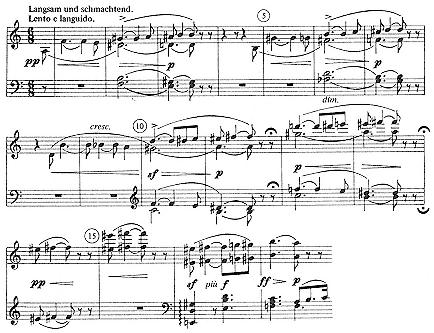
Example 18
Wagner, Tristan und Isolde . Prelude, mm. 1–17.
deceptive cadence defers, without on that account allowing the ear to forget that it has been cheated. What counts as a fulfillment is actually a rapturous occasion of unfulfillment.[28]
Set in motion by textual claims of bliss, the Lust -trope of Tristan und Isolde punctuates the lovers' discourse so that each release of desire, no matter how entrancing, becomes a further accumulation, a slippage of desire beyond its object. Three passages from act 2 can serve to illustrate this process.
The love duet that opens scene 2 reaches its first peak of intensity as Tristan and Isolde join in the phrase "Himmelhöchstes, Weltentrücken! Mein!" (Example 19). Starting with staggered entries on "höchstes," the lovers' voices ascend in parallel steps. On the second syllable of "entrücken," Isolde reaches the chromatic lower
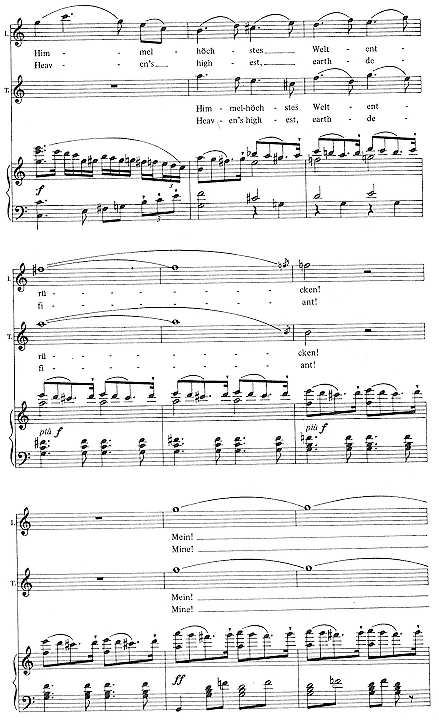
Example 19
Wagner, Tristan und Isolde . Act 2, "Himmelhöchstes."
neighbor of G (as

Shortly after this, a further peak of intensity occurs as Tristan and Isolde sing "Ewig, ewig ein!" in octaves (Example 20). Their vocal line reduces to a pair of resolutions:


The most dramatic instance of the Lust -trope in the opera is also the most famous: the interrupted cadence that curtails act 2, scene 2, as Brangäne shatters the lovers' idyll with a piercing shriek. On a first impression, it seems absurd to speak of mere deferral here, and still more absurd to speak of fulfillment. Brangäne's shriek is really a displaced death cry, the voice of the wound that Tristan will soon invite from Melot's sword. The disruption of the authentic B-major cadence in which the lovers seek a musical consummation is both brutal and unanswerable. Yet both Tristan and Isolde sustain their climactic melody note—in Isolde's case, a strong high-B—against Brangane's shriek and its attendant cacophony. For a tenacious moment of deafness, a moment in which the lovers "keep their positions as if entranced," the force of höchste Liebeslust seems to prevail. In a sense, the whole rest of the opera exists to recuperate and expand that moment. The B-major cadence that Brangäne's shriek revokes, even including the fall of the cadence on the words "höchste Lust," will be summoned back later—displaced, rendered more fluent, reechoed—as Isolde completes her Transfiguration.
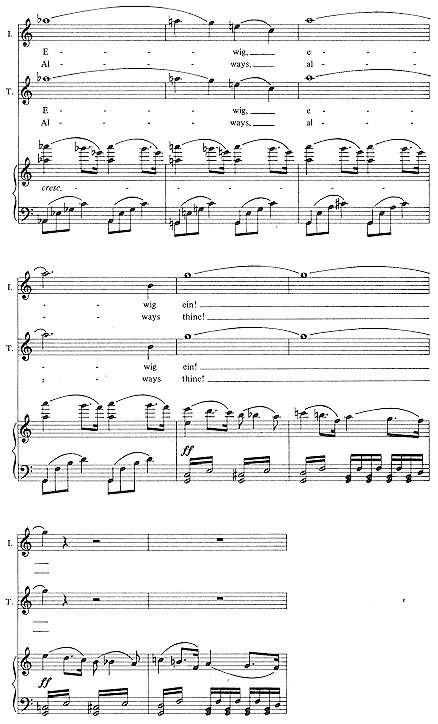
Example 20
Wagner, Tristan und Isolde . Act 2, "Ewig ein!"
The Transfiguration forms Wagner's means of opening what he calls, in his program note to the Prelude, "the breach that will reveal . . . the path into the sea of love's endless rapture."[29] Yet here a problem emerges—or, rather, the problem on which the whole opera turns. As we have seen, Wagner's Lust -trope concretizes the rhythms of a desire that has always already begun to resume even in the act of finding what Freud, with calculated irony, calls its "partial and temporary extinction."[30] Yet what Wagner seeks in Isolde's Transfiguration is the full and permanent extinction typical of classical, not libidinal, desire. His problem is to find a musical realization for this "final redemption" within the sphere of the fluid and never-final libido.[31] By common consent, he succeeds in doing this; as Joseph Kerman observes, the cadences that close the opera come with "unparalleled weight."[32] But where does this weight come from?
For a preliminary answer, we might focus on a series of cardinal moments in the opera, all of which center on the pitch b2 . The series begins with the cadence at m. 17 of the Prelude (which is also recapitulated at several critical junctures), continues with the catastrophe of Brangane's shriek, and closes with the B-major cadences of the Transfiguration. These moments chart the course of ultimate fulfillment as b2 metamorphoses from a preeminent appoggiatura to an unrealized tonic to a cadential tonic. The pitch gathers weight as its structural force is slowly clarified; large-scale resolution emerges from a process of intensification. Intensification, then, is the breach that Wagner requires: libidinal desire is rewarded not by extinction, but by an indefinite expansion "in measureless space, without barriers."[33]
Wagner concretizes this process by restructuring the Lust -trope in the Transfiguration. Where text and melody had once combined to reward a desire cheated by the harmony, harmony and melody now combine to reward a desire cheated by the text. To put this another way, most of the opera puts deferral and fulfillment into a narrative relationship; deferral acts as the means by which the story of desire
[29] Wagner, Prelude and Transfiguration , 47.
[30] Freud, Three Essays , 83.
[31] Wagner, Prelude and Transfiguration , 48.
[32] Joseph Kerman, Opera as Drama (New York, 1956), 212.
[33] Wagner, Prelude and Transfiguration , 48.
is prolonged. In the Transfiguration, the relationship becomes not narrative but figurative: deferral becomes a trope for the consummation of desire. As Wagner puts it in his program note, "the gates of union are thrown open" as the dying Isolde sinks onto Tristan's body.[34]
I would now like to take a closer look at the process of intensification by which Wagner arrives at Isolde's Transfiguration and its consummatory force—a process that the career of the pitch b2 epitomizes but by no means exhausts. Here again, the heart of the matter lies in the first seventeen measures of the Prelude, this time in the deployment of two basic sources of structure: the Desire motive and the Tristan chord. Heard on the oboe in mm. 2–3, the Desire motive consists of a semitonal ascent from G






The Prelude opens with a model (mm. 1–3) and a sequential statement (mm. 4–7). According to the standard account that I invoked earlier in this chapter, the model presents T as a local dissonance that resolves to the dominant seventh of A, whereupon the sequence presents T' as a local dissonance that resolves to the dominant seventh of C. Robert Bailey, mindful of the fact that the operatic version of the Prelude, unlike the concert version, ends in C, argues that the opening resolutions to E7 and G7 intimate what he calls a double-tonic complex, a situation in which two keys a minor third apart have equal claims, though at different times, to be the tonic. Bailey also demonstrates that it is at least possible to hear T and T' as structural sonorities, in particular as minor triads of


[34] Ibid.
[35] Robert Bailey, "An Analytical Study of the Sketches and Drafts," in Wagner, Prelude and Transfiguration , 113–46; Allen Forte, "New Approaches to the Linear Analysis of Music," Journal of the American Musicological Society 41 (1988): 315–48.
Desire motive and its sequential continuation return during the love duet of act 1, Wagner "actually replaces the earlier Tristan chords with the straightforward


The juxtaposition of the







The large-scale impact of T, T', and the Desire motive crystallizes when we recall that Isolde's Transfiguration not only ends in B, but also begins in

[36] Wagner, Prelude and Transfiguration , 121–23; quote 123.
[37] Forte, "New Approaches," 328. Forte actually hears the composite instead of the dominant ninth, in keeping with a general claim that linear processes in the Prelude are primary, tonal ones secondary (or even tertiary). My own position is that the music raises this question of primacy, but only in order to dramatize its undecidability.
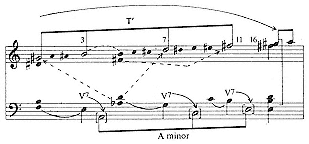
Example 21
Wagner, Tristan und Isolde . Prelude, mm. 1–17: graph.
Derived from Wagner, Prelude and Transfiguration
from Tristan and Isolde , ed. Robert Bailey (New York, 1985),
127–29, by Christopher Lewis, "Mirrors and Metaphors:
Reflections on Schoenberg and Nineteenth-Century
Tonality," 19th-Century Music 11 (1987): 30.
1. The Prelude establishes the double-tonic complex A/C, together with its shadow


2. Act 2 begins to accentuate the shadow, to give it a more dynamic presence. The reunion of Tristan and Isolde at the beginning of scene 2 gravitates toward climaxes in C, but the comsummatory love duet that begins with the phrase "O sink' hernieder, Nacht der Liebe," seeks closure in B. "O sink' hernieder," which marks the midpoint of the opera, also begins in



3. Act 3 begins in F minor—the relative minor of




[38] Wagner, Prelude and Transfiguration , 121–22.
[39] Ibid., 140.
effect of intensification, of expansion on the largest scale, also extends to the harmonic projection of the motive that occurs when we hear T and T' as added-sixth chords. To go a step further: if we think of the F-minor opening of Act 3 as an allusion to the F-major cadence at m. 17 of the Prelude, then the overall movement of the act forms a retrograde of the first two structural "sentences" of the opera: mm. 8–17, which evolve the cadence to F, and mm. 1–7, which establish the double-tonic complex(es) and set forth G

A further perspective on the Transfiguration can be drawn from the work of Allen Forte. Forte demonstrates that the Prelude is ruled by linear projections of T, T', and other collections, all of which represent the pitch-class set 4–27. For this reason, he regards the Tristan chord as "a self-standing musical object, not dependent for its meaning upon a resolution to some other sonority."[40] Considered in these terms, the Transfiguration gains its intensity not by expanding or clarifying previous tonal implications, but by reinterpreting linear events in tonal terms, releasing a flood of tonal meanings that has previously been dammed up. Forte's position would seem to rule out Bailey's not to mention the standard account, but it is neither necessary nor desirable to decide among the three. On the contrary, the triple ambiguity is precisely what this music seeks. The lack of definite structural boundaries, like the achievement of closure through intensification, conforms to the rhythm of libidinal desire.
The accentuation of the G


[40] Forte, "New Approaches," 327n .
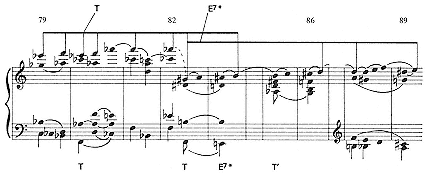
Example 22
Wagner, Tristan und Isolde . Linear graph of Prelude, mm.
79–89. From Allen Forte, "New Approaches to the Linear
Analysis of Music," JAMS 41 (1988): 333.
identifies the chord as an inversion of T instead of/as well as a dominant seventh.)
The lovers' apostrophe, "O sink' hernieder, Nacht der Liebe," at the midpoint of act 2 brings a similar interlock closer to the foreground. Tristan's vocal line for this phrase is an explicit ascending arpeggiation of T; Isolde's line is a more decorated descending arpeggiation (Example 23; Isolde closes with an octave displacement that also embraces an ascending form of T). The two lines overlap so that Isolde enters descending from C






Before that can happen, however, Tristan must die. It is at Tristan's death that Wagner begins the restructuring of the Lust -trope that will come to fruition in the Transfiguration. Isolde, arrived from Cornwall at last, holds the dying Tristan in her arms while the Prelude is recapitulated from the Desire motive to the F-major deceptive cadence and a little beyond. At first the music is very loud and agitated; Tristan, after all, is dying at the very moment of reunion. Yet the clamor and agitation steadily subside, as does the tempo, yielding at last to a tranquillity that irradiates the cadence. In another instance of expansion into "measureless space," Wagner
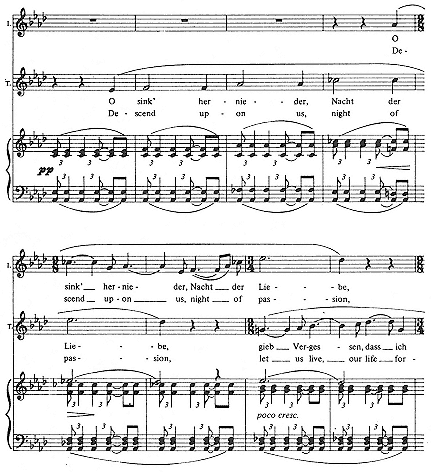
Example 23
Wagner, Tristan und Isolde . Act 2.
gives the cadence an unprecedented breadth, sustaining its B

As Tristan dies, Wagner intimates that the A/C complex of act 1 dies with him. In the Prelude, the deceptive cadence is followed by a C-major progression from the dominant side that ends with a cadential downbeat (mm. 18–20); this is answered by a quasi-
cadential plagal progression to the triad of A major (mm. 20–21). (The progressions are linked by introductory D-chords in modally altered roles,

What does follow at this point is Isolde singing the strangely affirmative words "Ich bin's." She sings them twice: first to the step A–G


The Transfiguration, where all such processes culminate, is less something that Isolde does than something she embodies. In musical terms, the essential action occurs in the orchestra. Isolde's role is to reperform that action as a speech act, the force of which is to cancel the impression of tragedy, to construe intensity of passion as a religious illumination—as what Kerman calls "the compelling higher reality of our spiritual universe."[41]
The music itself is, famously, a recapitulation of two passages, one in










[41] Kerman, Opera as Drama , 195.

Example 24
Wagner, Tristan und Isolde . Opening of Transfiguration.
as




The crowning process of the Transfiguration centers on two rhythmically variant versions of the same theme, identified as x and x ' in Example 25. At the words "Heller schallend," x makes a climactic arrival and sounds three times over plagal cadences. Related melodic figures then project an ascent by semitones from G


1. Both x ' and the "Heller schallend" statement of x form projections of B and G





[42] Wagner, Prelude and Transfiguration , 146.
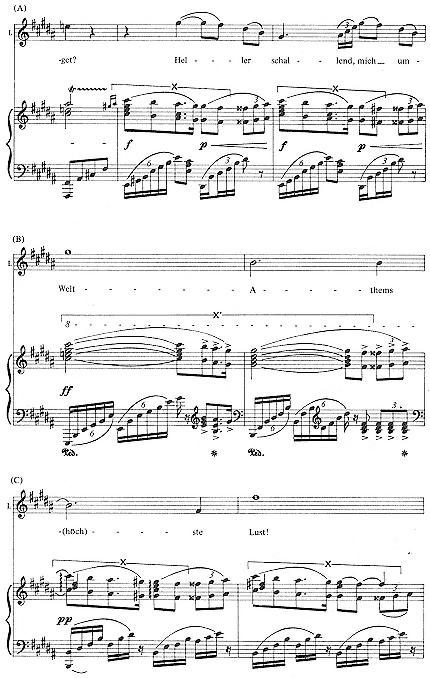
Example 25
Wagner, Tristan und Isolde . Transfiguration.
2. The prominence of E major as IV throughout the closing pages of the opera also bears more than one meaning. It represents both an expansion of the plagal cadence that effects the transition between the

3. The "höchste Lust" version of x completes the restructuring of the Lust -trope by reinterpreting the master tones G



In dramatic terms, this transfiguration comes to Isolde not merely in but by means of Tristan's metamorphosis from a real to an imaginary object of desire. Isolde's text begins with the fantasy that Tristan is alive, is smiling, is awakening. This fictitious Tristan is then dissolved into a fluid element, explicitly identified with the music we are hearing, that pours from Tristan to Isolde and finally envelops her, its origin forgotten:
|
[43] Ibid., 97.
|
This passage conforms in every detail to the Freudian language of love. The ego-libido that was invested in the beloved as object-libido now flows back onto the subject and becomes ego-libido once more, yielding a flood of narcissistic pleasure so overwhelming that the ego drowns in it. The transitional moment in this process is the dissolution of Tristan's image: the moment that Isolde sings "Heller schallend" while theme x makes its first climactic appearance.
The movement of psychosexual regression is also embodied in the "regressive," that is, the recapitulatory character of the Transfiguration as a whole. The music returns Isolde to the scene of her fullest earlier rapture and completes in fantasy the cadence/consummation that was shattered in reality. Even the material omitted from the recapitulation plays a role in this. In act 2, the future

Isolde's dispersal of Tristan's image—and her own awareness—into the unqualified movement of "höchste Lust" also testifies to a weakening of gender boundaries. In its original form, the

[44] Ibid., 96–97; translation by Andrew Porter.
female. It may even be that the subject expressing itself in Isolde's voice is Desire itself, impelled, as Foucault says it must be, to reveal itself as the truth.
Throughout the opera, as has often been noted, Wagner portrays Tristan and Isolde in terms that reverse certain deeply entrenched gender roles. Tristan, the most passive and masochistic of heroes, occupies a traditionally feminine position. Constantly wounded, he ought to embody male anxieties about castration, dependency, and impotence; instead he assumes the traditional feminine power to attract, to entrance, the other. Isolde is the more active, the more traditionally "masculine" of the lovers. When she brandishes and then extinguishes the hymeneal torch in act 2, she appropriates, seemingly with no resistance from Wagner, an age-old masculine position, not to mention the phallus itself.
The apostrophe, "O sink' hernieder, Nacht der Liebe," perfectly epitomizes the mobility of gender between Tristan and Isolde. The crisscrossing arpeggiations of T in the vocal lines intimate a sexual difference that is also a sexual sameness. Masculine and feminine overlap as mirror images of each other, and this just as the lovers ask for a forgetfulness in which their separate identities will fade away ("gib Vergessen, daß ich lebe"). Not that Tristan and Isolde could be anything other than a heterosexual couple. Wagner's own sexuality (or its idealization) is plainly embodied in Tristan, and besides, the convention is inexorable; Tchaikovsky, too, wrote heterosexual operas. Nonetheless, Tristan and Isolde are constituted as subjects in terms that scuttle the concepts of instinct, of the primacy of the object, of sexuality as a force of nature, even of Nature itself. They are constituted as subjects by a desire that overflows all boundaries, and for which gender is finally no more than a pretext.